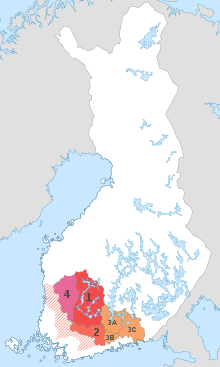Tavastian dialects
| Tavastian dialects | |
|---|---|
| Hämäläismurteet | |
| Native to | Finland |
| Language codes | |
| ISO 639-3 | – |
| Glottolog | hame1240 |
 Dialect area | |
Tavastian dialects(Finnish:Hämäläismurteet) are WesternFinnishdialects spoken in parts ofWesternandSouthern Finland.The dialect spoken in the city ofTampereis part of the Tavastian dialects.[1]The Tavastian dialects have influenced other Finnish dialects (especially theSouthwest Finnish dialects).
Dialectal features
[edit]Pronunciation of D
[edit]Where Standard Finnish has/d/,the Tavastian dialects have either/r/or/l/in its place. Ther-pronunciation is the more common one. Thel-pronunciation is encountered on two separate areas: in the eastern boundary of the dialect area as well as in a smaller area which includesAkaaandTammelato name a few.
Therefore,lehdet(leaves) can be pronounced aslehretorlehlet.However, the plural ofvesi(water, standard pluralvedet) can be pronounced asvesetin ther-dialects, in order to not cause confusion withveret(bloods, plural ofveri).
Pronunciation ofts
[edit]Instead of the standard consonant clusterts,tt(long/t/) is used, e.g.metsä(forest) ismettä.It is not affected by consonant gradation, so thegenitiveform ismettän.
At least historically, the dialects ofTuusula,Pornainenand nearby areas used assinstead, e.g.messä,genitive:messän.This has mainly been supplanted by the more commontt-pronunciation.
Diphthongs uo, yö and ie
[edit]The Standard Finnish diphthongs /uo/, /yö/ and /ie/ correspond respectively to /ua/, /yä/ and /iä/. For example,nuori(young) is pronouncednuari.
Long a and ä
[edit]As is the case for other western Finnish dialects, the Tavastian dialects mostly use the standard-likeaaandää.The dialects nearIkaalinenare an exception, asaaandäähave developed intooo(long[ɔ]) andee(long[ɛ]) respectively, e.g.mooinstead ofmaaandpeeinstead ofpää.Nowadays this feature is rarer.[3]
A diphthongization ofääintoiäoriehas been attested from the dialects nearHollola,e.g.päämay bepiäorpieandleipää( "bread",partitive) may beleipiäorleipie.This feature is rare nowadays.
-eaand-eä
[edit]-eaand-eäare most notably used as a suffix foradjectives.In the Tavastian dialects, the most common variant of this is-ee,e.g.korkeeinstead ofkorkea(high). The variant used for shorter words, such aspimeä(dark), may be eitherpimeeorpimmee,depending on whether the dialect hasgeminationor not.[4]
The standard-ea-type is found in northernPäijät-Häme,such as inNastola,HollolaandHeinola.
A rare-ie-type (korkie, pimie) has been attested fromLammi,HämeenkoskiandPadasjoki.
Theh-sound after unstressed syllables has been preserved in the dialects ofKymenlaakso.For example,lampaat(sheep, plural) may belampahatas in manySouthern Ostrobothnian dialectsandtupaan(illative oftupa) may betupahsimilarly to its equivalent in theKarelian language.Other Tavastian dialects have not preserved this sound.
Illative case
[edit]Third infinitive
[edit]A suffix-Vn(whereVcorresponds to the preceding vowel) is used instead of the standard-maan/-mään,e.g.ottaan, tekeeninstead ofottamaan, tekemään.
Other features
[edit]In the Tavastian dialects, /ŋk/, doesn't change with consonant gradiation: henki - henken (standard Finnish: henki - hengen).
In the southeastern Tavastian dialects, words often have a final -i, that is not found in standard Finnish, Tavastian min nimei 'my name' (standard Finnish: minun nimi).[5]
See also
[edit]References
[edit]- ^"KOSKESTA VOIMAA - TAMPEREEN MURRE".historia.tampere.fi.Retrieved2021-10-07.
- ^"Hämäläismurteiden piirteitä".sokl.uef.fi(in Finnish). Archived fromthe originalon May 12, 2021.RetrievedJuly 12,2022.
- ^"Pitkän a:n, ä:n diftongiutuminen".sokl.uef.fi(in Finnish). Archived fromthe originalon May 13, 2021.RetrievedAugust 11,2022.
- ^"Vokaaliyhtymä -ea, -eä".sokl.uef.fi(in Finnish). Archived fromthe originalon May 13, 2021.RetrievedJuly 12,2022.
- ^Rapola, Martti. "Hämäläismurteista": 215.
{{cite journal}}:Cite journal requires|journal=(help)
